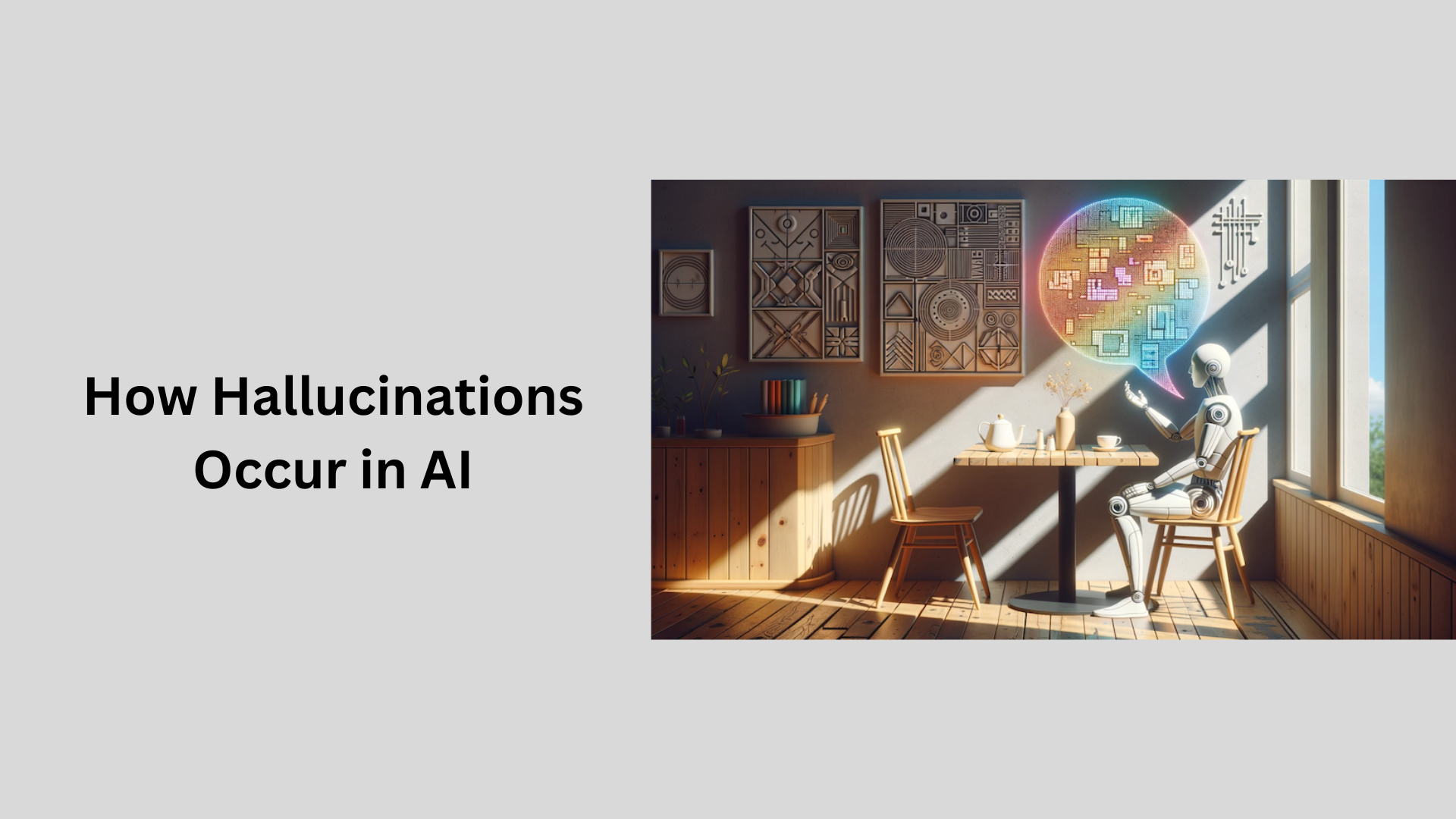Have you ever wondered how AI models, like chatbots or virtual assistants, sometimes give answers that sound completely off or unrelated to the topic? This happens because of something called “hallucinations.” But don’t worry, we’re not talking about the kind of hallucinations humans experience. In the world of AI, hallucinations refer to when a model generates information that seems believable but isn’t actually backed by any real data or facts.
In this article, we’ll explore what hallucinations are, why they happen, and what steps experts are taking to reduce these errors in large language models. We’ll also look at expert opinions on this interesting issue.
What Are Hallucinations in Large Language Models?
Hallucinations in large language models (LLMs) happen when an AI like ChatGPT produces an output that looks correct but is actually wrong or nonsensical. These hallucinations in LLMs happen because the AI is trained on a lot of data and may “hallucinate” information that wasn’t in the original training data. It occurs when the model tries to predict natural language responses but ends up creating something that doesn’t match real-world facts or logic.
The hallucination problem in large language models is a big issue for AI systems like ChatGPT. It can make the output unreliable, especially when these models are used for tasks that need correct information. Hallucinations in LLMs can create information that seems useful but is actually incorrect. Detecting and fixing hallucinations in large language models is an important focus in machine learning and artificial intelligence research.

Understanding How Hallucinations Occur in AI
Understanding how hallucinations occur in AI is key to improving the reliability of models like ChatGPT. Hallucinations in large language models often happen because of the innate limitation of large language systems. Since these models use patterns from training data to generate responses, they might create outputs that seem accurate but are not true. Experts in natural language processing and computation and language suggest that LLMs sometimes mix up information or make things up, which leads to hallucinations. This is why hallucination detection is becoming an important focus in AI research.
While hallucination is inevitable to some extent, efforts are being made to mitigate hallucinations in models using LLMs. According to studies from the Association for Computational Linguistics, AI models, including generative AI systems, can have varying hallucination rates based on their training and language generation capabilities. For example, legal hallucinations can be risky if used in legal research without proper verification. Many tools are being developed to help with detecting hallucinations, and improvements in human language technologies are aimed at reducing this limitation of large language models.
Real-World Examples of Hallucinations in Language Models
Hallucinations in large language models can appear in various real-world scenarios, causing issues in the reliability of LLM responses. For example, in the context of LLMs, a model might confidently produce incorrect information, making it difficult for users to trust the model outputs. A common type of hallucination occurs when an AI system like an AI chatbot provides answers that seem factual but are actually made up. This can be problematic, especially in critical fields like LLMs for legal research, where accuracy is essential. To improve the reliability of LLMs, researchers use methods like reinforcement learning from human feedback to detect and mitigate these hallucinations.
Some notable examples of hallucinations include studies discussed at the Annual Meeting of the Association and the American Chapter of the Association, where AI models provided incorrect results in natural language inference tasks. Research from the University of Oxford has explored ways to retrain the model and reduce errors in AI systems. The semantic understanding of language models is crucial for their accurate deployment in real-world applications. Here are a few real-world cases where hallucinations in large language models were noticed:
- An AI chatbot generated incorrect legal advice during a simulated LLMs for legal research task.
- At a conference of the North American AI community, researchers highlighted how hallucination may occur in medical AI tools.
- A PDF of the paper titled on AI ethics showed how AI technologies need to be retrained to handle complex queries.
These examples show that while LLMs are powerful, ensuring AI safety and reducing hallucinations requires continuous improvement in AI technologies.
The Role of Data in Causing Hallucinations
The role of data plays a significant part in causing hallucinations in large language models. Since models like LLMs are trained on vast datasets, the quality of the data directly impacts the reliability of the generated language. If the training data contains gaps, incorrect information, or lacks context, LLMs may fail to internalize real-world facts properly. This can lead to factual hallucinations, where the LLM generates content that appears correct but isn’t. Hallucination is certainly a challenge when the use of AI involves answering complex or open domain question answering tasks.
How Data Quality Affects Hallucinations
When data using LLMs is incomplete or biased, it can result in the model producing incorrect responses. Models learn from the input data, and poor data quality can guide the generation of unreliable content. This is why AI researchers focus on improving the datasets to minimize these hallucinations across models.
Why Some Models Are Prone to Hallucinations
Different models are more or less prone to hallucinations depending on how they were trained and the type of data they were fed. In some cases, controlled hallucinations are allowed for creative tasks, but they can be harmful when answering legal questions or other factual queries.
The Impact of Hallucinations on Real-World Use
The reliability of LLMs in real-world scenarios is affected by the data they are trained on. When LLMs to produce content are based on faulty data, the risks of using them for critical tasks increase. This is why it’s crucial to continuously refine the data and improve the use of AI in everyday applications.

What Techniques Are Used to Prevent Hallucination in LLMs?
Language model developers are constantly working on ways to make these AI systems more accurate and reduce the chance of hallucination. Here are some of the main techniques they use:
- Fine-tuning: This process involves retraining a model on specific data to make it more accurate in certain contexts. By fine-tuning a model, developers can ensure that it gives more precise answers in particular fields like medicine, law, or science.
- Data Verification: One method is to verify the information generated by the AI against external sources. If the information can’t be backed up by real data or sources, the AI is trained to reject it.
- Multi-step Evaluation: After the model generates an answer, a second step can be added to evaluate the response by checking it against a reliable database or source. If the answer doesn’t match, it’s flagged as potentially incorrect.
- Using Retrieval-Augmented Generation (RAG): This is a hybrid model that combines the strengths of retrieval systems (like search engines) with the generative ability of large language models. The model fetches relevant information from external sources and then generates an answer based on it, reducing the chance of hallucinations.
- Constrained Output Generation: Instead of letting the model generate any possible answer, developers can limit the range of outputs to predefined categories or options. This reduces the chance of the AI coming up with something wildly inaccurate.
Here is what Habibur Rahman, Co-Founder and COO of AIBuster, says about this:
“Hallucination occurs when a model generates responses that aren’t grounded in data or context. To prevent hallucination, you have to choose between encouraging the model’s creativity and rigorously grounding its outputs in verifiable data. That’s why when you’re adapting a generative model like GPT-4, fine-tuning is extremely important. This process narrows the model’s focus, improving both the accuracy and relevance of its outputs. But if the model is too narrowly fine-tuned, it might become less versatile across broader contexts.”
Chatbot provider Swiftron.eu mitigates language model hallucinations through an advanced verification process:
“To prevent hallucination in language models, a multi-step process is employed. First, the model generates an answer based on retrieved content, which can potentially include hallucinations. Next, a second prompt challenges the model to find word-by-word matching citations from the source text that support the generated answer. Finally, these citations are verified character by character against the source text. If no citations are returned or if more than 10% of the characters vary, the content is considered hallucinated. This method ensures that only accurate, contextually relevant information is presented.”

